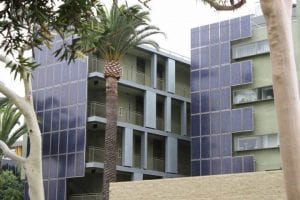The iconic Sydney Opera House is going green, and cutting its $2.5 million annual electricity bill, by signing long-term contracts to source its electricity from a major wind farm and a large solar project, and may add batteries later.
Under a deal negotiated with renewable energy retailer Flow Power, and announced on World Environment Day, the Sydney Opera House will contract to buy 16 gigawatt hours of wind and solar output a year from the Sapphire wind farm and the Bomen solar farm, both located in NSW.
This equates to the amount of electricity that the Sydney Opera House consumes each year, and according to Ian Cashen, executive director of building, will be matched for around 85 per cent of the time.
The rest will be hedged by Flow Power, a relative newcomer to the corporate energy market that is already making a name for itself co-ordinating renewable energy contracts with large energy users.
The 170MW Sapphire wind farm is located near Glen Innes in northern NSW (Barnaby Joyce’s electorate) and is mostly contracted to the ACT government, as part of its own 100 per cent renewable target for 2020.
The wind farm is owned by Grassroots Renewable Energy, a partnership between CWP Renewables and Partners Group. Flow earlier this year contracted to take the output for 50MW of capacity, presumably to put together a deal like this.
The 100MW Bomen solar farm – located near Wagga Wagga in the electorate of Joyce’s successor as National Party leader, Michael McCormack – was developed by Renew Estate and recently bought by Spark Infrastructure , and has also contracted a large part of its capacity to Westpac, as part of that bank’s own commitment to 100 per cent renewables.

“We’re really pleased with the outcome,” Cashen told RenewEconomy in an interview. Cashen said the Opera House took advantage of the expiry of its existing energy supply contract, and with its goal of carbon neutrality, and its long standing sustainability objectives in mind, set out to find a new green energy supplier.
Cashen says the long term contracts through Flow Power – for seven years, with options to extend – not only delivers a lower electricity price than it would otherwise have got, but also locks in a low price for the period of the contract. That, he says, would not have been possible with a standard energy contract based around coal power.
“It’s a modest saving, but the important thing for us is that it is not just about straight savings calculations, it’s getting some certainty as well.” That certainty can be delivered because while wind and solar farms have high up front costs – and so like to get long term contracts – the operating costs are low and predictable, because there is no variable fuel cost.
Cashen says adding, or contracting, a big battery is also an option down the track, to allow the Sydney Opera House to get closer to perfectly matching the consumption at the building through the production and storage from the wind and solar farm.
“What our modelling shows is what we can get, with wind and solar, a pretty good match. We tend to need a low but consistent load during the day, and that ramps up towards the afternoon and evening. This matches very well with combination with wind and solar supply profile. We might do a battery later on – we will keep our mind open.”
And, of course, the option of rooftop solar on the building, with its iconic “sails”, was not an option. “Yes, that is the running joke. You can’t put a turbine on site, or solar panels on the sails. So this works very well for us.”
Cashen noted that the Sydney Opera House always had a strong sustainability theme, pursuing tri-generation options easy in the peak, using sea water through a heat exchange system to defray air conditioning consumption, building artificial reefs on its harbour foreshore, and getting a 5 green star green building rating, the first World Heritage building to obtain one.
“Sustainability goes to a lot of our core values,” he says. “We are recognised as being a heritage site, but there is a really strong alignment between heritage and sustainability.








